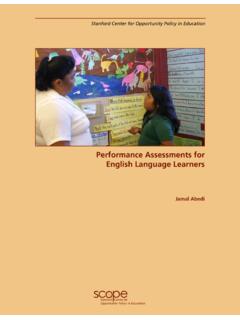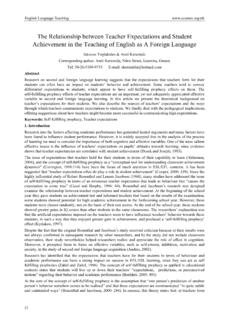Transcription of Amharic Language Manual
1 Amharic Language and Culture Manual National Language of Ethiopia Image from CIA World Factbook Prepared by Amanda Wimsatt and Rachel Wynn Texas State University class of 2011 [TY P E T H E C O M P A N Y A D D RE S S] amandalicious Amharic Language and Culture Manual Page | 2 Table of Contents About Demographics and Linguistic Writing 5 Geographical Distribution of the Possible Errors in Speech, and Social Medical Language and Culture Manual Page | 3 About Ethiopia Ethiopia s total population is 88,013,491, making it the world s 14th most populous country. Ethiopia is located in eastern Africa, just west of Somalia. It is a landlocked country with a central mountain range divided by the Great Rift Valley.
2 With a history of over 3000 years, Ethiopia is the only African country that was never colonized. The country was ruled by Emperor Haile Selassie from 1930 to 1973. Selassie was overthrown in 1973 by military personnel that formed a repressive Marxist military regime. Since this repression Ethiopia has struggled with drought and famine. Prior to the 1973 military coup few Ethiopians lived in the west. However, since the coup many families have left Ethiopia as refugees as a result of the internal wars and ethnic conflicts. Leaving Ethiopia is dangerous and many people do not survive the journey. The greatest number of Ethiopian refugees coming to the United States occurred from 1983 to 1993. Most refugees came from urban backgrounds and have obtained college degrees. Areas of the United States with greatest population of Ethiopians include the East and West coasts, Dallas, and Houston. Image from CIA World Factbook Amharic Language and Culture Manual Page | 4 Demographics and Language Amharic (also known as Abyssinian, Amarinya, Amarigna, and Ethiopian) is the national Language of Ethiopia.
3 Since the 13th century is has been the Language of the court and dominant population in Highland Ethiopia. The Language of Amharic is spoken in the Ethiopian government, court system, and on all official documents. Amharic is predominately spoken by upper and middle class Ethiopians. According to the 1994 census Amharic is the most commonly spoken Language in Ethiopia. It is spoken by over 17 million people in Ethiopia. Amharic speakers encompass of Ethiopia s population. Amharic is also spoken by 40,000 people in Israel as well as people in Egypt and Sweden. Other languages in Ethiopia are spoken in rural areas throughout Ethiopia. Of the other 85 languages spoken in Ethiopia the following are most prevalent: Oromigna , Tigrigna , Somaligna 6%, Guaragigna , Sidamigna , and Hadiyigna Ethnologue provides information about all languages spoken in Ethiopia. Ethiopia is also home to more than 200 dialects.
4 In 1991 a new constitution gave all ethnic groups the right to develop their own languages and use their Language as method for instruction in primary schools. Primary schools are taught in Amharic and other local languages. Secondary schools and universities utilize english for education. english is the most popular foreign Language spoken in Ethiopia. According to the United States census (2000) African languages (including Amharic , Ibo, Twi, Yoruba, Bantu, Swahili, and Somali) were spoken by 418,505 persons living within the US. A Community Survey (2006) reported 696,607 speakers of African languages in the US. Amharic Language and Culture Manual Page | 5 Linguistic Features Writing System Amharic has its own writing system, a semi-syllabic system. There is no agreed translation of Amharic symbols to Roman characters (used in english ).
5 There are 33 consonant symbols that have seven variations. Variations are according to the vowel that is coupled with the consonant. About one quarter of Ethiopia s population is literate in the written form of Amharic . Image from Phonology IPA translation of Amharic sounds. Symbols in parentheses represent deviations from standard IPA symbols. Amharic Language and Culture Manual Page | 6 Amharic includes glottalized series of consonant phonemes, which is characteristic of the sound system. Syllable structure is represented as CVCC. Consonant clusters will not appear in initial position. Stress may occur on each syllable, but the last syllable tends to be unstressed. Consonants Image from Vowels Images from Errors in english common for native speakers of Amharic In Amharic , there is an absence of combinations.
6 An example of a combination would be an s- cluster. Also, the presence of ejectives in the Amharic Language and the absence of this feature in the english Language is an observable difference. Voiceless stops, affricates, or sibilant fricatives can become ejectives. In Amharic , the consonant sounds /p/, /t/, /k/, and /s/ can be produced as ejectives. Another distinct feature is that Amharic speakers will demonstrate epenthesis vowel sounds before an s- cluster or in the middle of pl- or kl- cluster because these clusters do not exist in Amharic . Additionally some predictable patterns of Amharic speakers are that final consonants are often devoiced or deleted, fricatives may become stops, stops may become fricatives, and vowels are often shortened, lowered, or raised. Morphology The typical clause order in Amharic is noun + object + verb. Amharic Language and Culture Manual Page | 7 Nouns may denote gender, number, definiteness, case, and direct object status by affixes prefixes and suffixes, predominately suffixes.
7 Amharic nouns may have a masculine or feminine gender. Suffixes are added to denote a masculine or feminine noun gender. Some nouns may have both masculine and feminine gender, while other nouns may only have one gender. The feminine gender is used to indicate female as well as smallness. Plurals are indicated by the suffix o . Affixes are added in the following order: gender, number, definiteness, case, and direct object status. Pronouns: Amharic is a pro-drop Language . Sentences with no emphasized element do not require independent pronouns. The verb denotes the person, number, and gender. Object pronoun suffixes are affixed to verbs and indicate person, number, and gender of the object of a verb. Possessive suffixes are affixed to nouns to indicate possession. Personal Pronouns Images from Verbs are derived from roots and affixes to inflect person, number, gender, aspect, mood, voice, and polarity are added.
8 Verbs agree with their subjects. Verb agreement with objects is optional. Verbs are placed at the end of the sentence. Adjectives are predominately derived from nouns, verbs, and other parts of speech. Pragmatics Communication tends to be direct, with most people usually speaking softly. Finger beckoning should be directed at children only. To beckon an adult point and extend the arm and hand, then hold hand out with palm down and repeatedly close hand. Prolonged eye contact may be considered disrespectful. When gesturing for silence Amharic Language and Culture Manual Page | 8 use one finger over the lips for children and four fingers for an adult. To gesture no Ethiopians shake their from side to side for both children and adults. Little emotion or affect is shown to strangers, but physical affection is common between friends.
9 Fellman (1976) describes the Amhara as very talkative and loquacious. Greetings are lengthy as well as their responses. Responses pay tribute to God. Phrases and sentences are often long and complex. (In written form there is limited punctuation.) Riddle games are shared between children and adults alike. In addition to being loquacious, the Amhara are often sarcastic in their speech. Fellman describes backbiting, insulting, arguing, and litigating as common characteristics of speech. The surface structure of a sentence may be innocuous, but the core may be biting. Geographical distribution of the Language Amharic is the official Language of the country of Ethiopia. Ethiopia includes many ethnic groups with nearly 80 languages and approximately 200 dialects. Major groups include the Amhara, Oromo and Tigre. Smaller groups include Afad-Isa, Somali, Wolaita, Sidama, Kimbata and Hadiya. The Language of Amharic is spoken in the Ethiopian government, court system, and on all official documents.
10 The Language spoken at the secondary and university education level is english . Amharic is the Language spoken by the wealthier upper and middle classes in Ethiopia. The rural areas throughout the country speak the many other languages and dialects previously mentioned. Possible Errors and Reasons There are sounds in the Amharic and english phonetic inventories that overlap but there are differences in the inventories also. Consonant sounds that do not occur in Amharic will be deleted or replaced when speaking english . Charts were included previously that show the consonants and vowels present in the Language of Amharic . To avoid misidentification of a difference as a disorder, the speech- Language pathologist should give credit for changes that are expected to occur. In Amharic , there is an absence of combinations. An example of a combination would be an s- cluster. Also, the presence of ejectives in the Amharic Language and the absence of this feature in the english Language is an observable difference.











